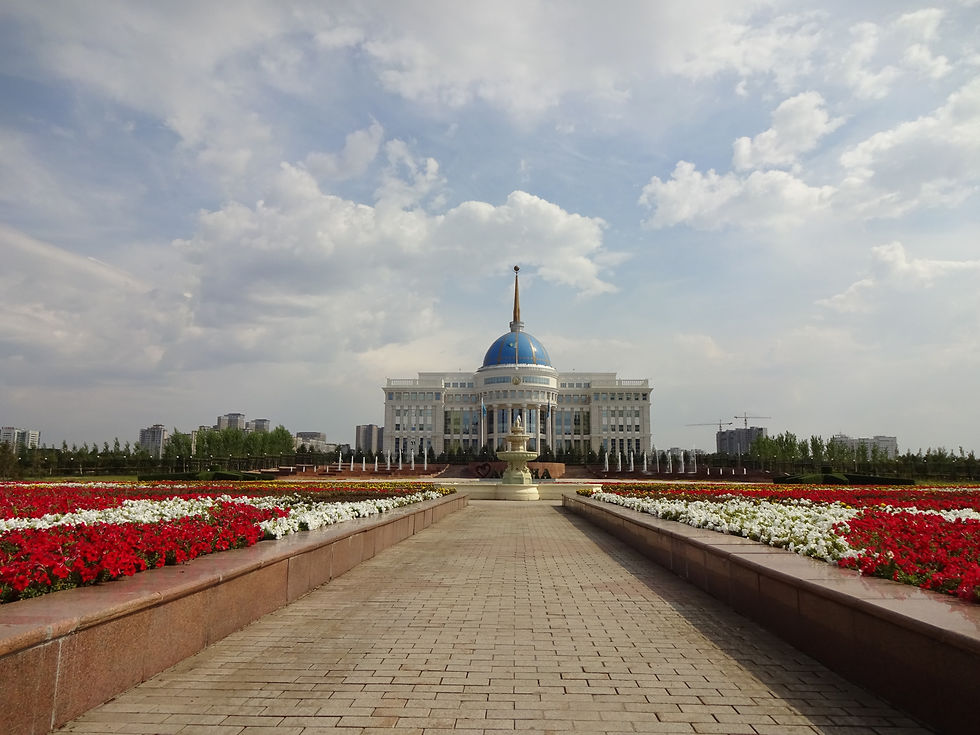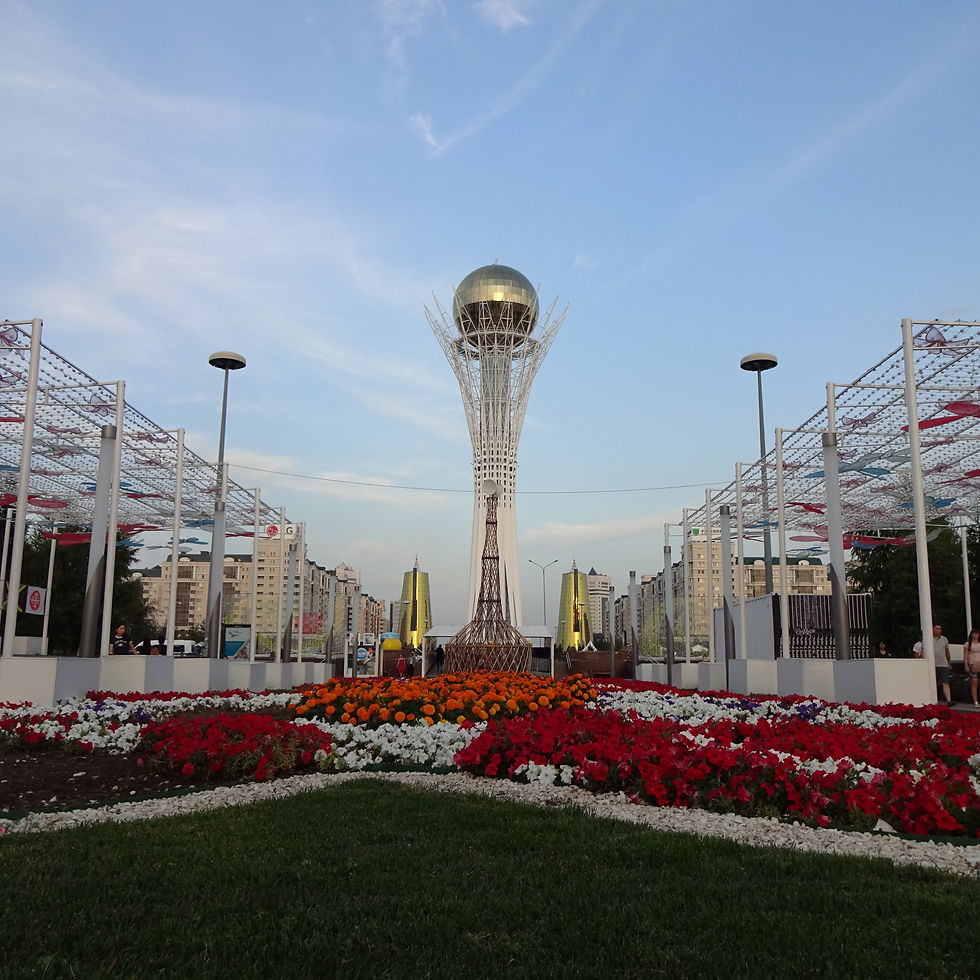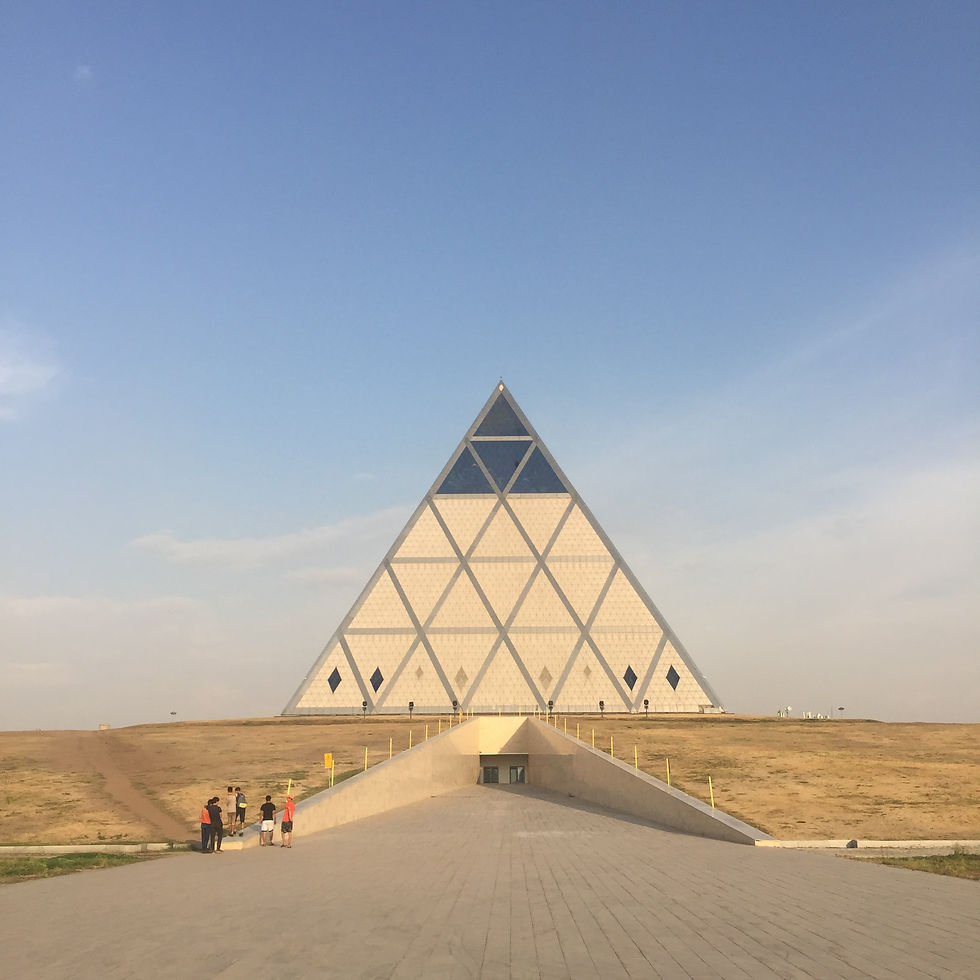Nursultan’s Nur-Sultan
- Samuel Garrett
- Oct 1, 2021
- 4 min read
Updated: Nov 12, 2021

Samuel Garrett
Kazakhstan’s capital is a mainstay on lists of the world’s most unusual places. Nur-Sultan, once known as Astana, now bears the name of Kazakhstan’s former president, Nursultan Nazarbayev, whose autocratic rule over the country lasted almost 30 years. Abroad, Nur-Sultan is largely known as a caricatured oddity, its striking Disney-esque architecture inviting an ogling gaze. It even provides a wealth of material for conspiracy theorists, who read occult meaning into its design. Rather than occult theories, however, Nur-Sultan has very real subtext as a highly deliberate and planned symbol of the country’s erstwhile ruler and the particular conception of modernity which he sought to project.
Nur-Sultan’s ‘left bank’, south of the Ishim river which divides the city, presents a smorgasbord of futuristic oddities towering above the surrounding steppe. The presidential palace Ak Orda, looking rather like two stacked White Houses, sits across from the world’s largest tent, Khan Shatyr, which houses a shopping centre, indoor beach and a rollercoaster. Between them on Nurzhol Boulevard stands Bayterek tower, a golden ball seemingly floating above a 105-metre-tall frame. Visitors can ride a lift to the top and place their palm in the golden handprint of Nazarbayev himself. There is little that is human-scaled. One is instead made to stand in awe of the New Kazakhstan, and implicitly, the achievements of Nazarbayev himself.

Lawmakers voted to rename Astana to Nur-Sultan in Nazarbayev’s honour the day after his 2019 resignation, but the influence of the ex-president pervades the city beyond just its name. Astana Day coincides with Nazarbayev’s birthday, and Nazarbayev statues, posters and namesakes can be found throughout Nur-Sultan. Unsurprisingly, mentions of the corruption and suppression of political dissent under his leadership do not enjoy the same exposure.
While the area around the city has been inhabited since the Bronze Age, it was Nazarbayev’s decision to relocate the capital in 1997 from Almaty to the regional town then known as Akmola. The official justification was that Almaty was prone to earthquakes and lacked room for expansion, but the reality was more political. Geographic centrality is certainly useful, Nur-Sultan following the lead of planned capitals such as Brasilia in this sense, but some suggest the relocation was more likely a strategic move to quell ethnic separatism in the country’s north.
Moreover, a clean slate allowed for the construction of a steel and glass testament to a version of the country Nazarbayev sought to craft. Nur-Sultan’s rapid and distinctive growth since then has largely been by his design (quite literally, if one believes the official narrative of the origins of Bayterek tower). Often termed the “Dubai of the steppe”, Nur-Sultan core image is one of wealth, stability and modernity. A special economic zone seeks to attract foreign investment and the city has seen extremely rapid development, leading the country in residential building construction. The works of renowned architects, such as the Norman Foster-designed Khan Shatyr and pyramidal Palace of Peace and Reconciliation, further produce a veneer of international legitimacy. Domestically, it has promoted the creation of a national identity independent of Kazakhstan’s Soviet history. Internationally, it has helped craft an image of development and prosperity that belies the regime’s authoritarian character.

Particularly notable is the extent to which Nur-Sultan, and Kazakhstan by extension, has become an increasingly significant diplomatic locus. Negotiations and Expo 2017 (the site of which now hosts the world’s largest spherical building) have contributed to Kazakhstan’s image of stable neutrality, which local media are keen to hail as significant progress. Such a project requires a capital steeped in a sanitised, heroic version of history and a constructed version of a future in which riches bring greatness and modernity means monuments and glass towers.
The story of Kazakhstan certainly is remarkable, given its economic turnaround amidst limited opportunities and a fraught geopolitical situation after the breakup of the Soviet Union. But significant questions remain as to who this progress has most benefited, and how national history is remembered in a country where politics remains tightly controlled.
In what should be the thriving heart of the country, there is an overriding sense of emptiness. In 2009, Nazarbayev himself said “this city is so sterile”, in reference to its long winters, but the city’s lack of life extends beyond the germ-killing ability of –30ºC temperatures. The first generation of Nur-Sultan natives is only now coming of age, and despite the city’s modern facade, many young people see no future in the city beyond its educational and commercial institutions.
For all its flashiness and central planning, Nur-Sultan’s urban design more generally remains imperfect, suffering from congestion and facing criticism from popular bloggers, as well as from current President Kassym-Jomart Tokayev, for its administration and lack of a unified architectural style. Rapacious development has also held environmental implications for surrounding ecosystems, a trend only likely to continue as the city grows.
Nur-Sultan purports to be an exemplary symbol of a new Kazakh identity, but its vapidity reflects the cynicism of resource wealth put towards the maintenance of control. It is striking how such a place of apparent whimsy could ultimately prove so bland.

Samuel Garrett is the Young Diplomats Society’s Regional Correspondent for South and Central Asia, and a student of Arabic and International Relations at the University of Sydney.

















Comments